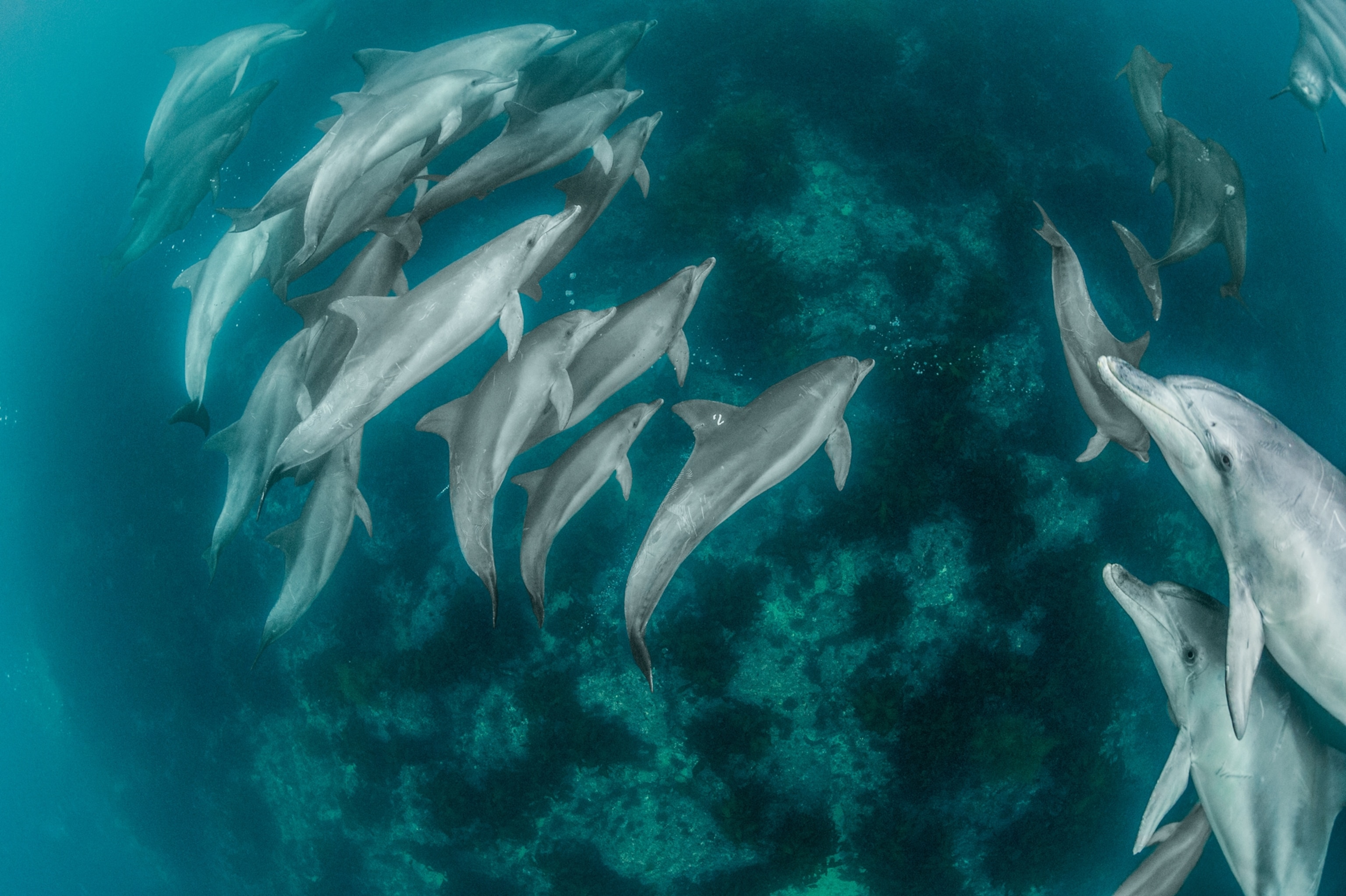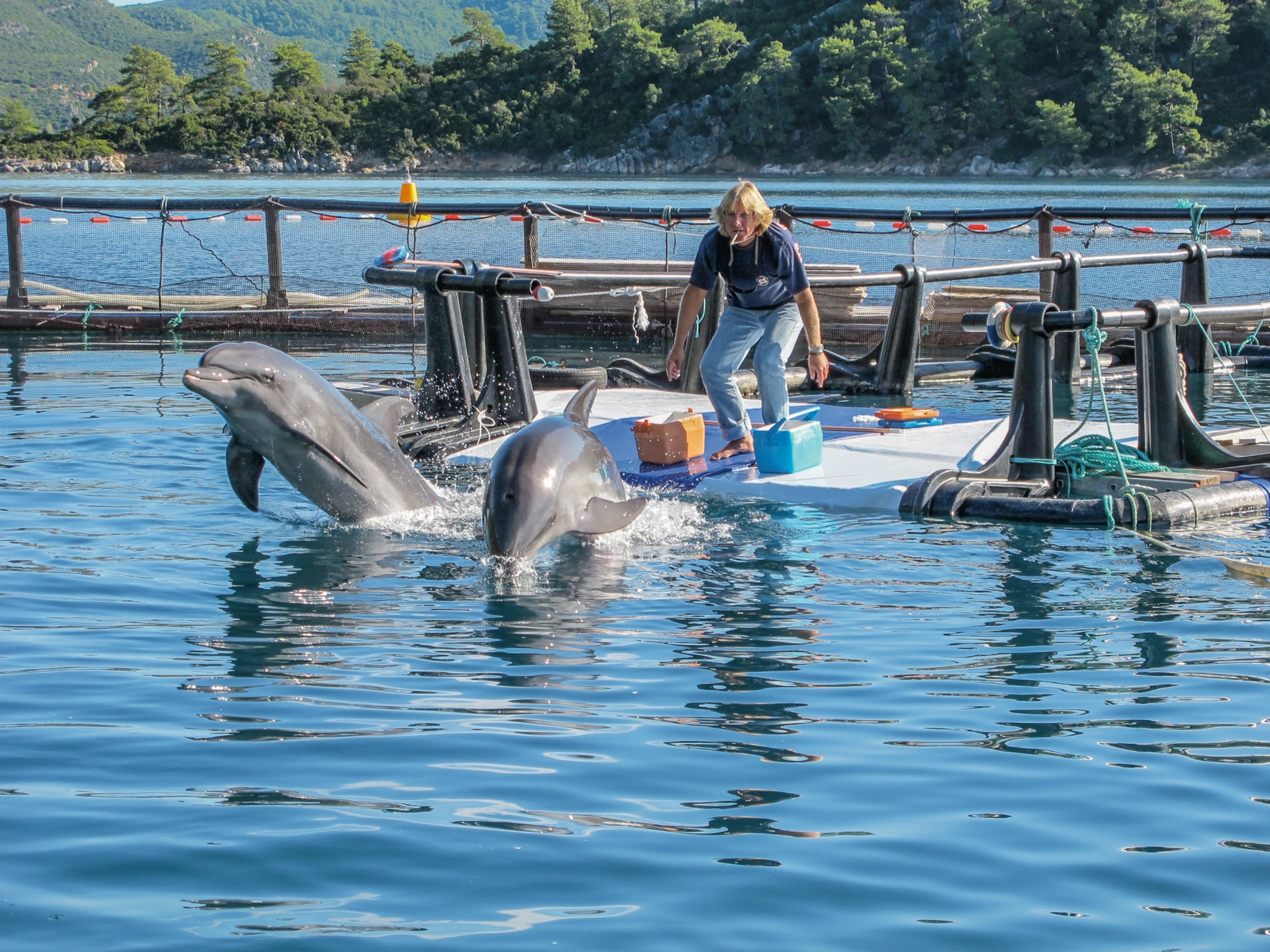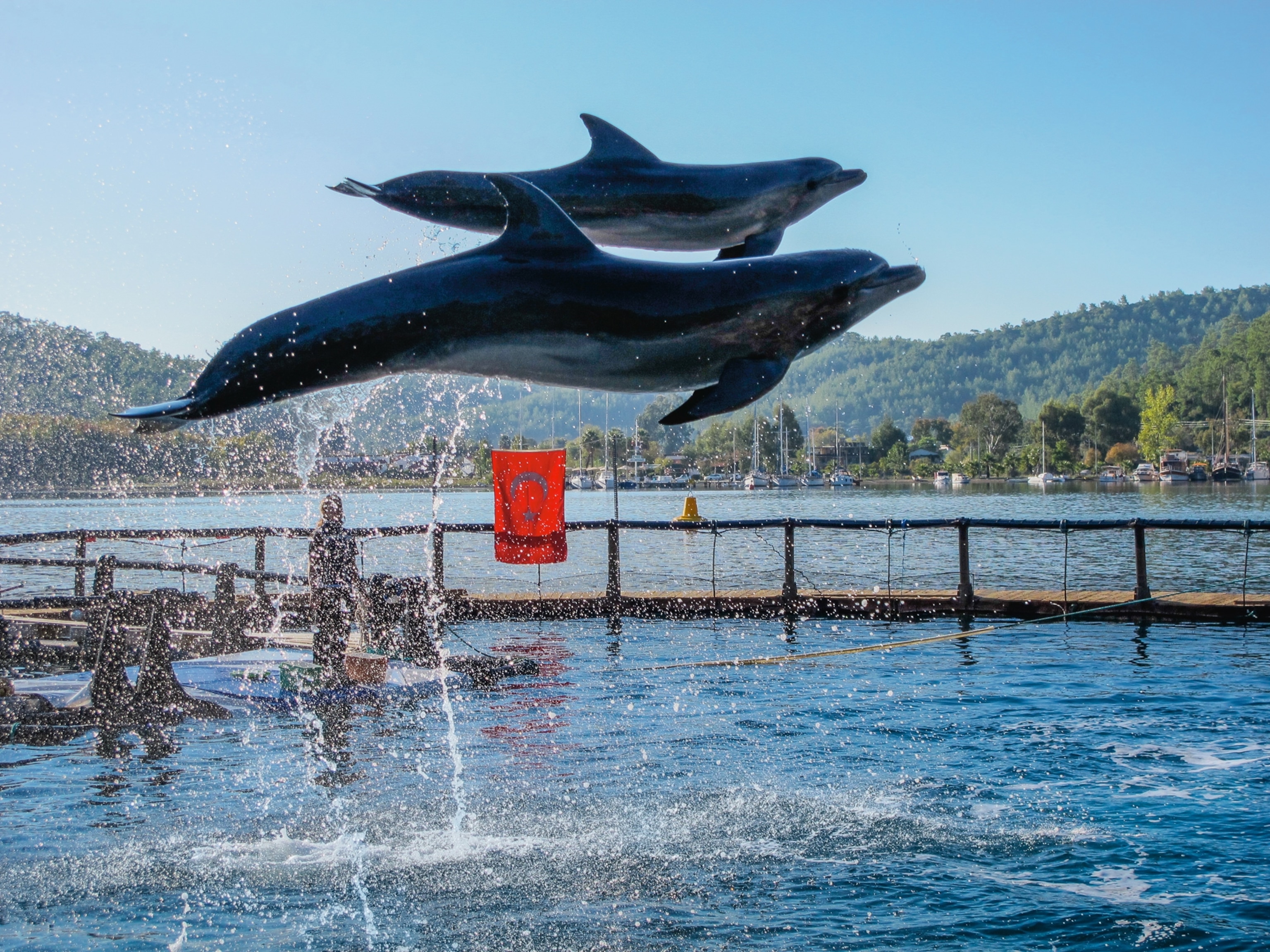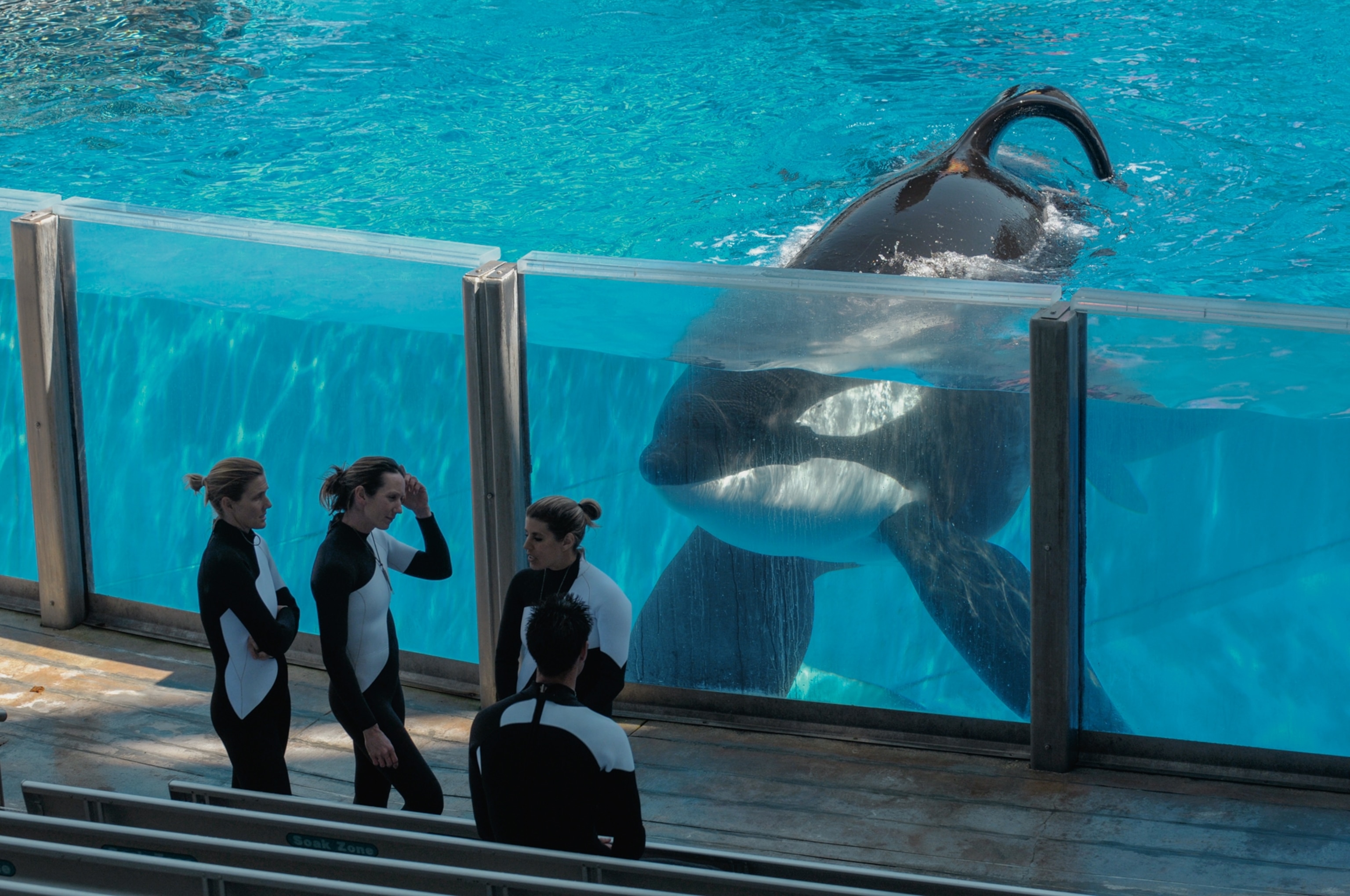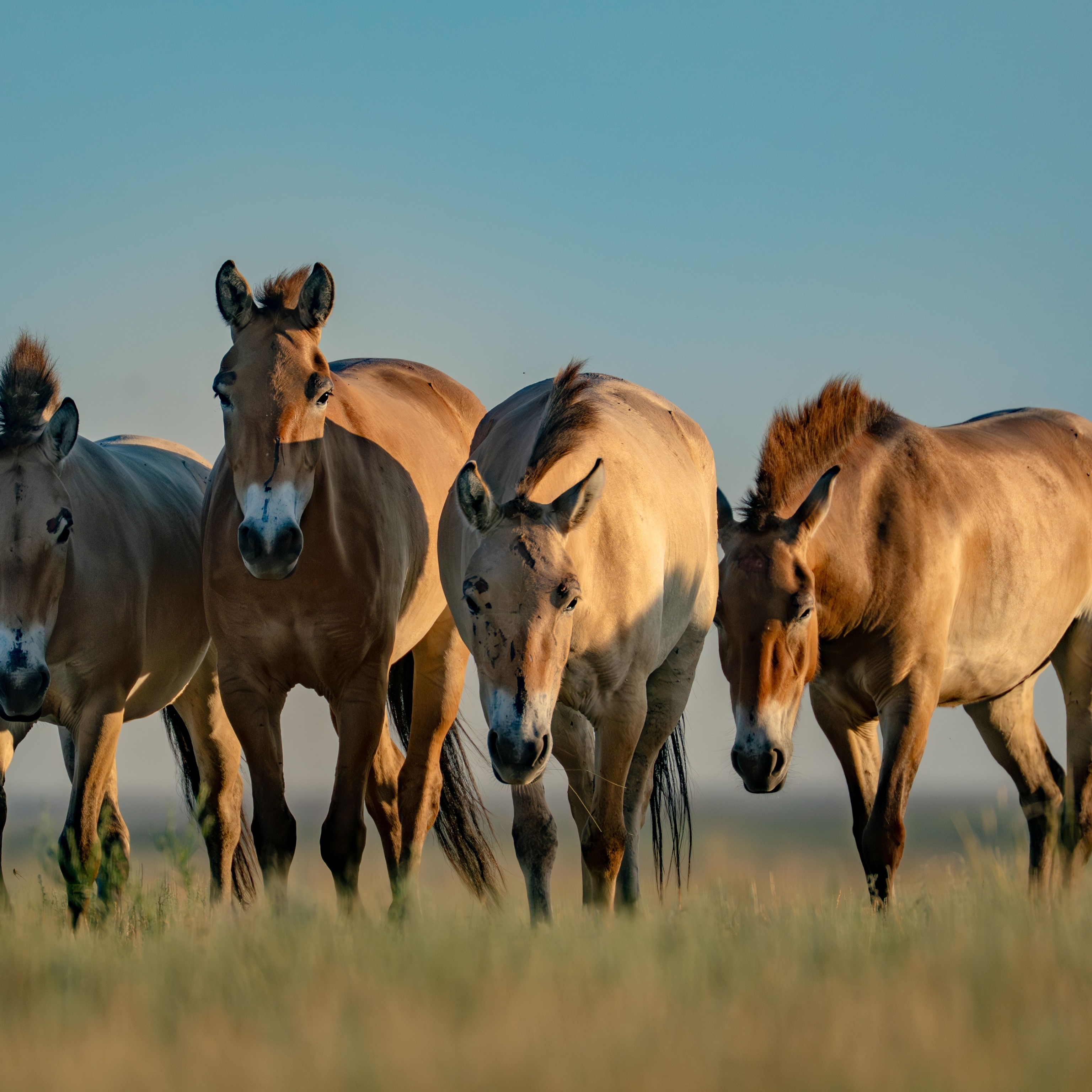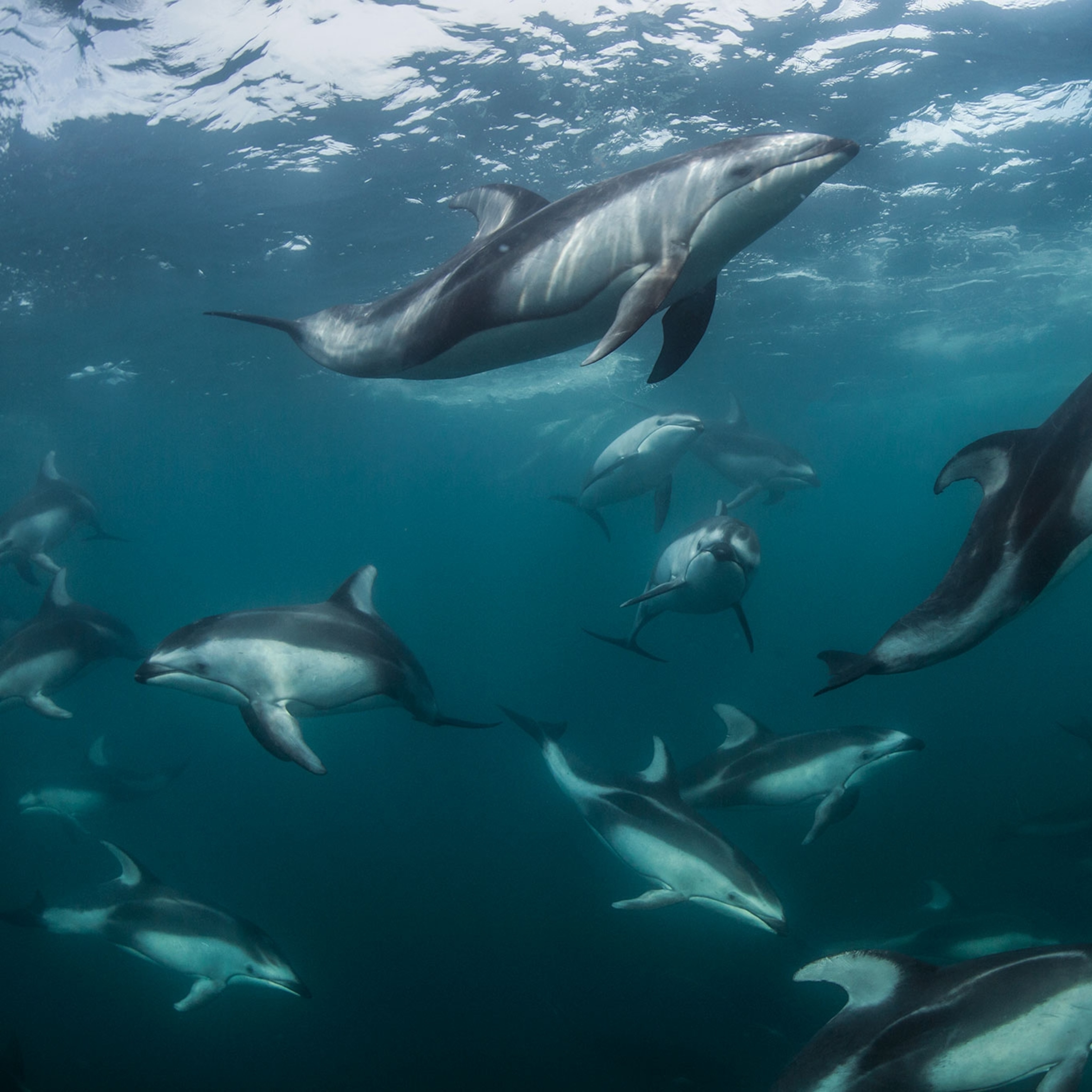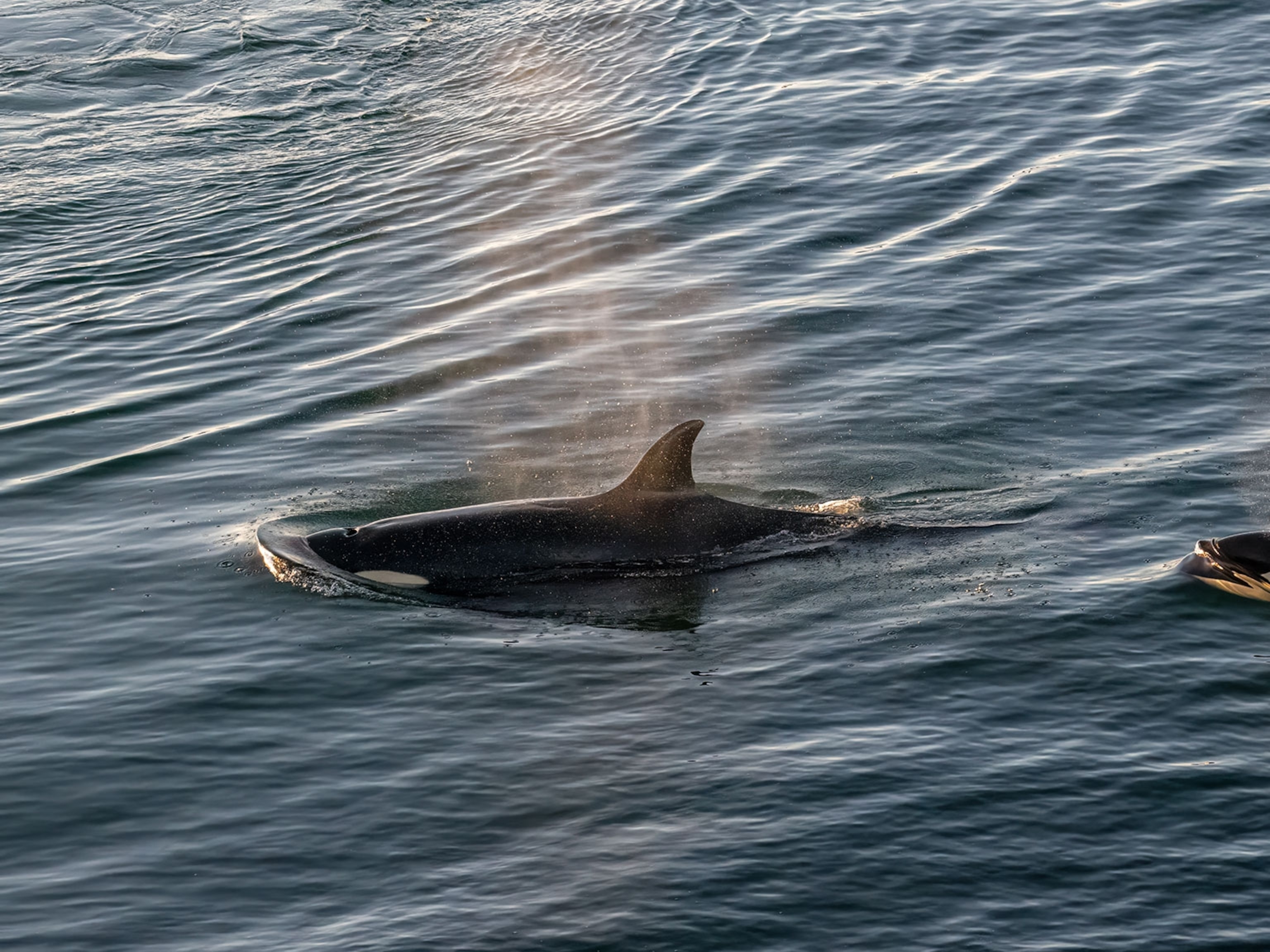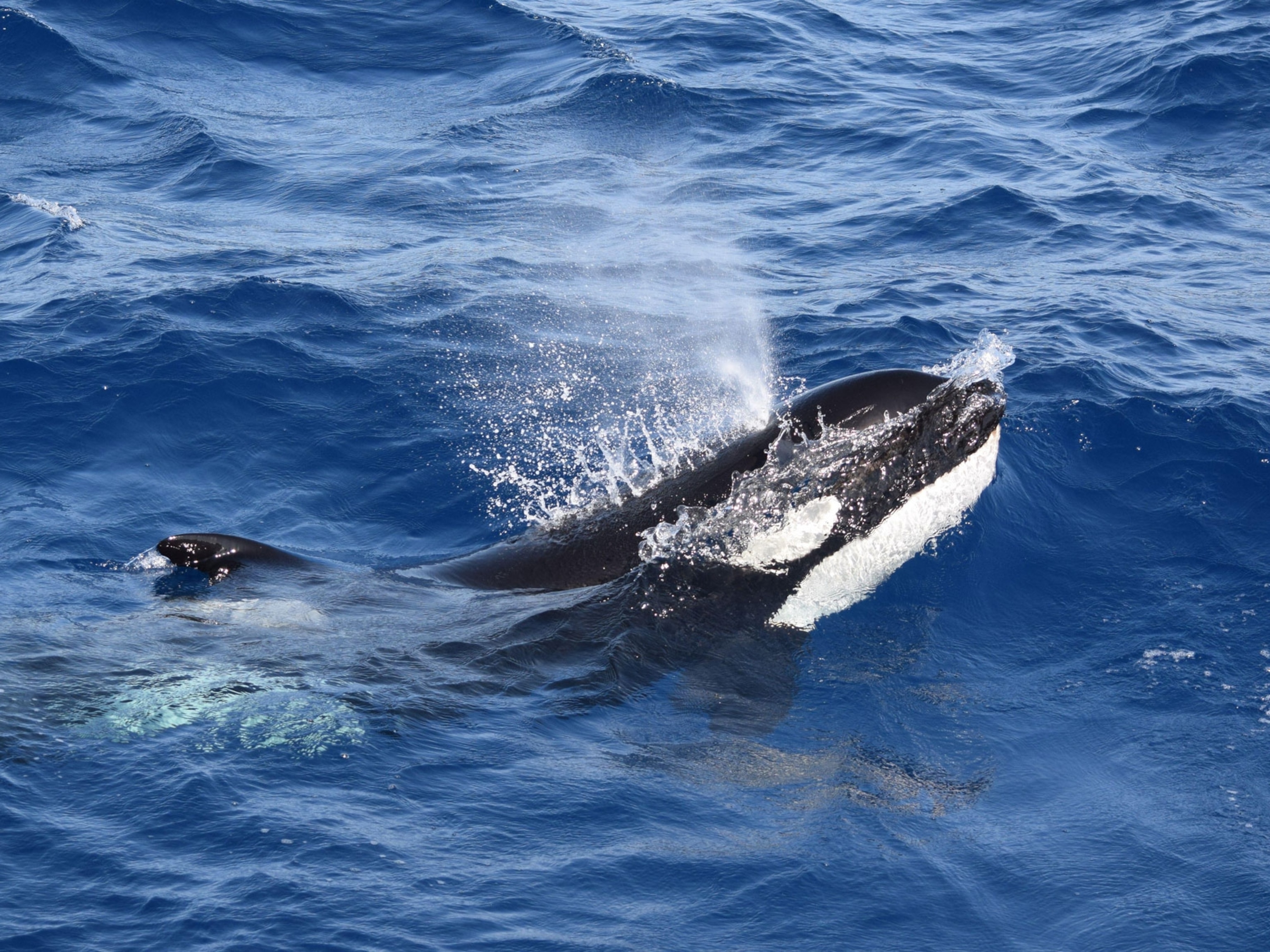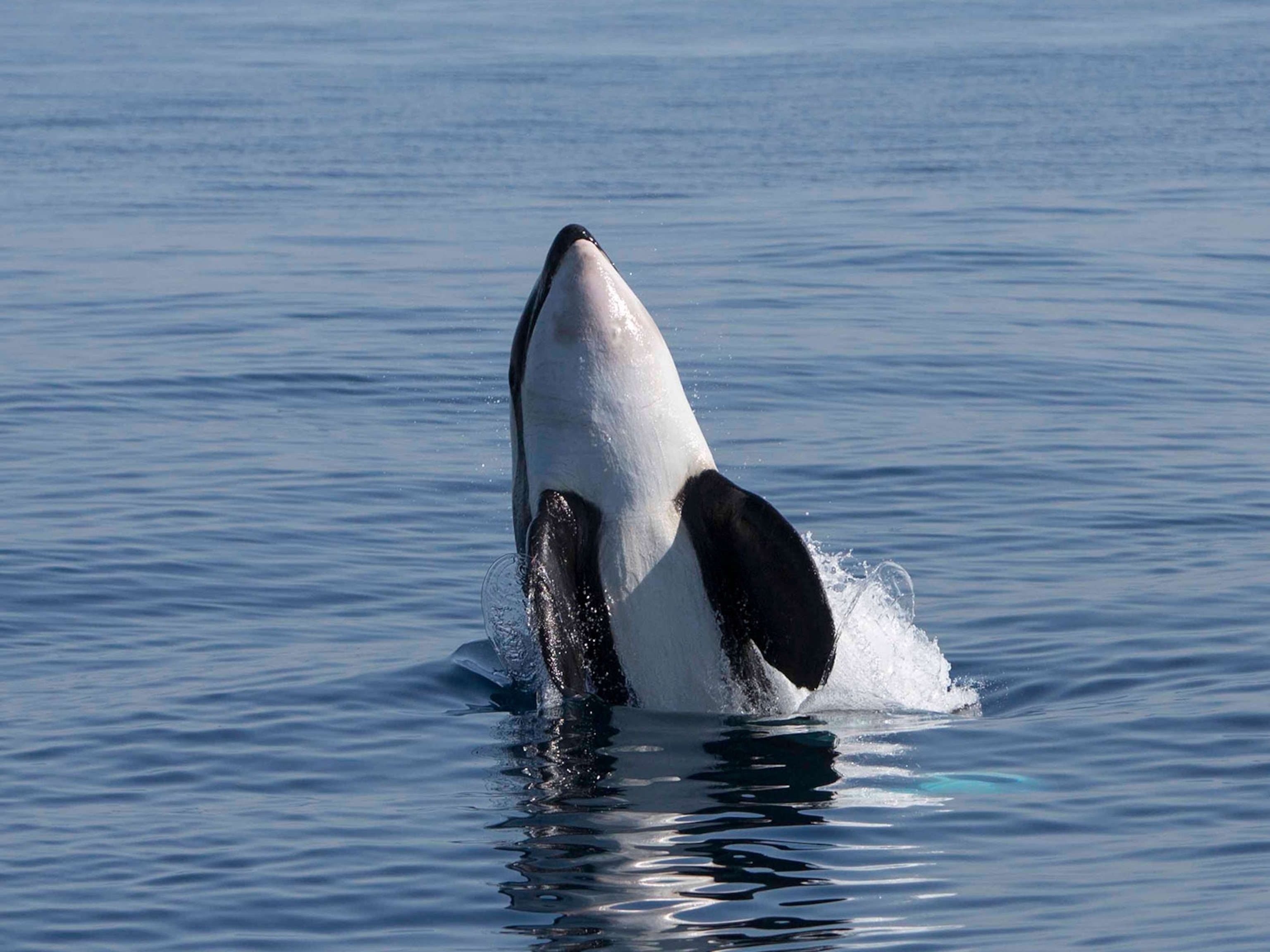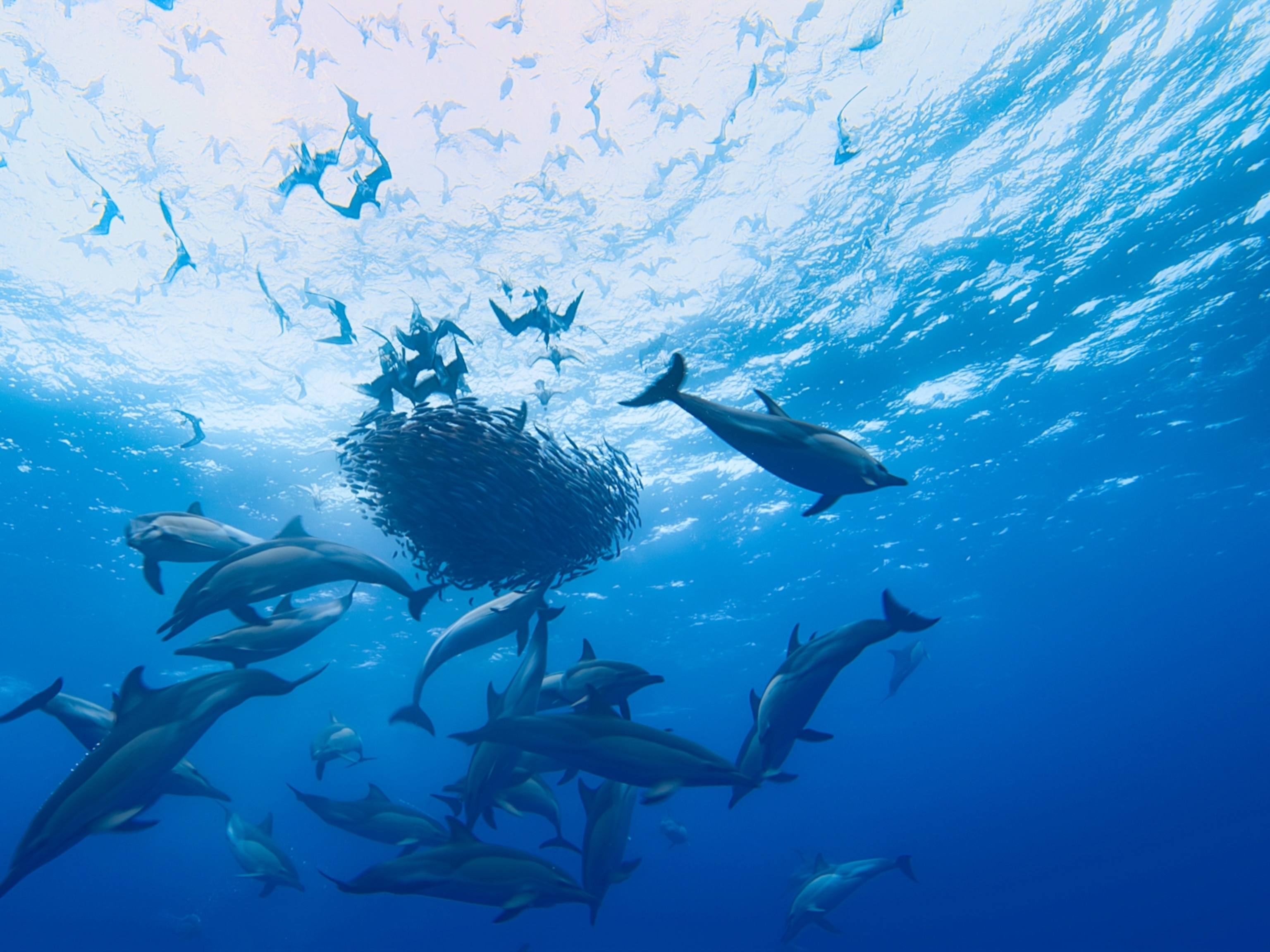Can Captive Dolphins Return to the Wild
Thousands of dolphins have been taken captive to perform in shows at marine parks. Now some are being taught how to go home again.
In early January 2011 Jeff Foster, a 55-year-old marine mammal expert from Seattle, arrived on the stony shore of a pristine bay near the small village of Karaca, situated in a corner of the Gulf of Gökova on Turkey’s southwest coast. Just offshore was a collection of floating pens used to farm fish. In one of them, which had been modified and measured about a hundred feet across and 50 feet deep, two male bottlenose dolphins swam in slow circles.
Tom and Misha, as they were called, were in lamentable condition. As far as anyone could tell, they’d been captured in the Aegean sometime in 2006, and almost nothing was known about their lives in the wild. After starting their captive lives at a dolphin park in the seaside town of Kaş, they’d been trucked a short distance inland in June 2010 to a crudely constructed concrete pool in the mountain town of Hisarönü so that tourists could pay $50 for the chance to grab their dorsal fins and get a ten-minute tow. Hisarönü consists mainly of cheap hotels and bars with suggestive names like Oh Yes! and thumping late-night music. It would be hard to imagine a more incongruous or disorienting location for two ocean-born dolphins. An inadequate filtration system quickly left the bottom of their pool carpeted with dead fish and dolphin feces.
Within weeks, an outraged grassroots and social media campaign organized by dolphin-loving locals had forced the place to close. In early September, amid fears that the dolphins would soon die, the U.K.-based Born Free Foundation, which is dedicated to the protection of animals in the wild, stepped in and took possession of Tom and Misha. The two dolphins were bundled into a refrigerated meat truck lined with old mattresses and transported to the pen off Karaca. Foster was hired to help Born Free attempt something truly ambitious: restore Tom and Misha to peak physical condition, teach them what they would need to know to live as wild dolphins again, and release them back into the Aegean. “It is extremely high risk with a creature that is not predictable and easy,” says Will Travers, Born Free’s president. “But we realized that there were very few options for them, and they were likely to die unless somebody did something.”
Questions about the ethics of keeping dolphins in captivity, especially for public entertainment, have intensified as their intellectual and cognitive abilities become better understood. Dolphins are among the most intelligent species on the planet: self-aware, highly social, with brains that are notably large and complex for their body size. They’re capable of extensive communications and use signature whistles that are analogous to individual names. They can recognize themselves in a mirror and understand abstract concepts, and they’ve demonstrated a grasp of grammar and syntax.
Fewer than three dozen long-term captive dolphins had been released over the previous 50 years, with mixed and often inconclusive results. Tom and Misha offered an opportunity to elevate the art and science of teaching a dolphin to be wild again and better define at least one alternative to continued captivity. “This is the sort of thing that touches people to the core,” says Travers. “If we could get it right for Tom and Misha, it could inspire people and help people move along to question [captive dolphin] display.”
If Tom and Misha offered Born Free a chance to define the future, they offered Jeff Foster a chance at partial redemption. Foster has long blond hair, an easygoing manner, and the ruddy complexion of a man who’s severely allergic to office cubicles. The son of a Seattle veterinarian, he has always loved learning about animals and went to work for the Seattle Marine Aquarium at the age of 15. Starting in 1976, when he was 20, he helped Don Goldsberry, who became SeaWorld’s most prolific collector of marine mammals, set up an operation to catch orcas, or killer whales—the largest species of dolphin—in Iceland. Over the next 14 years Foster helped capture some two dozen killer whales for SeaWorld and other marine parks from waters off the United States as well as Iceland. In addition to killer whales, he took smaller dolphins, sea lions, seals, and other animals from the wild for captive display.
Though Foster tried not to wrestle too much with the question of whether Tom and Misha were helping him pay a karmic debt, the work felt right. He had caught his first killer whale because it was a far more interesting way to earn a living than flipping burgers, and he sincerely thought it was the best way to learn about a little-understood animal. But listening to the plaintive cries of young animals alone and confined on the deck of a capture boat taught him that the moral calculation was complex. He did his best to use his hands and voice to calm fearful and distressed young killer whales, and he refused to follow the practices of those who believed that withholding food would help break a killer whale and make it more submissive. Still, he says, “the more you do it, the more you realize you are separating families. You can’t feel good about taking something from the wild.”
Ironically Foster’s extensive experience bringing dolphins into captivity meant he was uniquely qualified to reverse the process. It also made him an awkward partner for Born Free. “Jeff was very much from the capture industry, and we were very nervous,” says Alison Hood, who supervised the project for Born Free. “But he is an absolute wealth of knowledge, and we had taken responsibility for Tom and Misha and had a responsibility to give them the best chance, no matter what.” Foster thought the process of rehabilitating Tom and Misha and preparing them for release might take six to eight months and cost $500,000—for the pen, the staff, the equipment, the live fish. Born Free hoped it would cost less than half that. They were both wrong.
Helping wild-caught dolphins return to the natural world they once knew so well is not as simple as it might seem. A captive dolphin has the same anatomy and DNA it had in the wild, but it is in many ways a different animal. A wild dolphin lives a life of unpredictability and competition. It socializes and hunts across a vast expanse, moving almost constantly, encountering a multitude of species and new situations. Apart from surfacing to breathe, a wild dolphin spends most of its life underwater.
The marine park experience is the wild inverted. The physical space is tightly constricted and relatively barren, life is on a schedule, and there’s no need to hunt and forage. Outside of training and shows, there’s also little need for movement. Most notably, a captive dolphin’s orientation changes profoundly: The world above the surface suddenly becomes much more important than the world below. Almost all the action—from feedings to training sessions to audiences applauding to the directions given during shows—is topside. One simple comparison makes the point. Wild dolphins spend an estimated 80 percent of their time well below the surface. Captive dolphins spend about 80 percent of their time at or near the surface.
Foster caught his last killer whale for captivity in 1990, though he continued to capture other dolphins and sea lions. But he’d also started devoting more time to wild whale research and from 1996 to 2001 was heavily involved in the attempt to return Keiko, the killer whale star of Free Willy, to its native Icelandic waters. (Keiko swam free in 2002 but died of pneumonia in 2003.) Foster moved from that controversial experiment to the successful 2002 rehabilitation and release back to her pod of a young female killer whale called Springer that had been found alone and malnourished off the coast of Washington State. “The captive industry thinks I am freeing animals and is very leery of some of the work we have done. I am kind of a pariah now,” Foster says. “But I am not anticaptivity. I am just pushing for the right thing.”
Foster had always prided himself on trying to understand the needs of the animals he was bringing into captivity so that he could help smooth the disorienting and stressful passage between the natural and human worlds. Getting accurate records on Tom and Misha proved impossible, but Born Free staff figured that the two had probably been captured near the large port of Izmir and then held in captivity for about four years. Tom was smaller, friskier, and seemed the younger of the pair. He was eager to please and appeared to have adapted better to captive life, swimming up to just about anyone who came out to the pen as if to ask, What’s up? What do you have for me?
Misha, in contrast, was standoffish and suspicious of anything new. When Foster tried to teach him to allow blood to be drawn from his fluke—necessary for monitoring his health—he shied away at the first sight of a syringe. He disliked the blood draw so much that the next time he stayed in the middle of the pen, waving his fluke in the air as if to say, You can look at it, but don’t touch. He was reluctant to engage with the human world and often spent time in the pen looking seaward. “How dolphins view captivity depends a lot on how you bring them into captivity,” Foster says. “If you don’t have proper care and conditioning, you can end up with animals who are more neurotic.”
The lingering effects of Tom and Misha’s hard life in marine parks were evident in their lethargy and in the fact that they were perhaps 20 percent underweight, with so little blubber their ribs could be seen. Preparing them to rejoin the world of wild dolphins would not be just a matter of teaching them how to hunt live fish again, reducing their contact with humans, and opening a gate. Foster knew he needed a more counterintuitive approach that would start with the same tools (a trainer’s whistle and target pole) and methods (“operant conditioning,” which rewards correct behaviors and ignores incorrect ones) used by marine parks all over the world to train dolphins to perform in shows.
Beyond being conditioned to allow blood draws—a process that involved getting Tom and Misha comfortable first with having their flukes handled, then pinched with a thumbnail or snapped with a rubber band to prepare them for the needle’s sting—both dolphins needed to learn to accept other basic health care procedures, such as allowing their blowholes to be swabbed for bacterial cultures. And Foster didn’t see how he could restore Tom and Misha to the Olympic level of fitness they would need to survive in the ocean if he didn’t first put them through a regimen of fast swims, jumps, and tail walks that would build muscle and stamina. “The only way is to train them so you can untrain them,” he says.
High-energy workouts require calories, so the first job was to overcome Tom’s and Misha’s picky eating habits and reacquaint them with the fish they would likely encounter in the Aegean, such as mullet, anchovies, and sardines. The strategy was to offer them a local fish species. If they ate it, they were rewarded with mackerel, a fish they’d developed a taste for in captivity. To mimic the unpredictability of food in the wild, Foster varied the amount and frequency of their meals. “When you bring them into captivity, everything from feeding to shows is very structured,” he says. “They develop a built-in clock and can tell exactly when they are going to get fed. We have to turn that around, because we know that in the wild they will eat more one day than another.”
Foster also wanted to wake up their highly capable dolphin brains. He dropped into the pen things they might not have seen for years, like an octopus or a jellyfish or a crab. He cut holes along the length of a PVC tube, stuffed it full of dead fish, and then plunked it into the water. Tom and Misha had to figure out how to manipulate the tube so that the fish would pop out of the holes. “In captivity we train the animals not to think on their own, to shut down their brains and do what we ask them to do,” Foster explains. “What we are trying to do when we release them into the wild is get them off autopilot and thinking again.”
The feeder tube had two other benefits. It floated about five feet below the surface, so Tom and Misha were reminded that food is found underwater. It also helped disassociate humans from the provision of food. “We had to get them to understand that fish doesn’t only come from a silver bucket and a person,” says Amy Souster, a young marine mammal trainer who was drafted into the project by Foster.
Getting Tom and Misha ready was a step-by-step process that continued through the spring of 2011, with up to 20 learning sessions a day. By the time the hot summer months approached, Foster was hopeful that Tom and Misha would be ready to swim free in early fall. But in the summer heat, with the bay’s temperature climbing to a dolphin-stressing 80 degrees or more, Tom and Misha lost their appetites and were hit by a virulent blood infection that was barely staved off by emergency tube feeding and a heavy dose of antibiotics. “That almost certainly would have killed them within a few days,” John Knight, Born Free’s consulting vet, recalls. “It was a very close call indeed.” Tom and Misha didn’t have a close bond and mostly tolerated each other. But Souster was moved to see Misha trying to care for Tom, pushing him to the surface to help him breathe when he sank to the bottom of the pen and taking him fish in an attempt to get him to eat.
To make matters worse, by the end of the summer the villagers in Karaca had made clear—by slashing the tires of Born Free cars, scratching them with keys, and eventually making rape threats against female staffers—that they were fed up with the project taking over their bay. In October 2011 the sea pen, with Tom and Misha inside, was carefully towed to a new location across the bay and anchored next to a sailing academy, which had generously offered the use of its extensive facilities. Foster and his team redoubled their efforts, with special emphasis on the dolphins’ physical conditioning. One popular workout involved fast swims back and forth across the pen, the dolphin equivalent of wind sprints. Another was trying to get them to swim ten laps around the perimeter of the pen at top speed.
The pen was now anchored about a hundred feet from the wooded shore, allowing Foster to turn to a favorite innovation from the Keiko project: an oversize slingshot that rotated on a stand and could be used to shoot fish with impressive accuracy into different parts of the pen. In addition to delivering food without direct human involvement, the slingshot encouraged Tom and Misha to get in the habit of moving more, as wild dolphins do. They soon got the idea, and just the thwap of the slingshot triggered their predatory reflexes. “They didn’t think. They would just wait for the next thing to hit the water,” Foster says. “That was when I knew it was time to introduce live fish.”
It’s one of the oddities of captivity that wild-caught dolphins no longer seem to understand that live fish are to be hunted and eaten. Tom and Misha would watch schools of fish swimming through their pen as if they were watching television. Foster had to train them to hunt and eat live fish again. He started by mixing live fish—initially slowed down by a bang on the head or a cut tail—into handfuls of dead fish that would be thrown into the pool. Tom and Misha had become so used to racing each other to gobble up anything that dropped into the water that without thinking they would eat the live fish along with the dead ones. Over time live fish—slowed less and less—made up an increasing portion of their feedings, until the dolphins were once again accustomed to the taste and to the idea that they had to catch their meals.
Foster next used five-gallon water jugs, with spring-loaded lids that could be opened remotely, to release live fish into the pen from multiple locations and at different depths, again taking humans out of the equation and focusing Tom’s and Misha’s attention underwater. Both dolphins started spending more time foraging for fish in the depths of the pen, even blowing bubbles from their blowholes to flush out fish hiding in spaces they couldn’t get to. Souster had been skeptical that captive dolphins could successfully be returned to the wild. “But I watched Tom and Misha change from lethargic, people-oriented animals, focused on food coming from buckets, to animals that would go crazy for live fish and acting the way wild dolphins should act,” she says. “It was incredible.”
Foster agreed. It was time to open the gate.
May 9, 2012, was a crisp and promising cobalt-sky day. A large crowd of Born Free staff and supporters gathered nearby. Early that morning Tom and Misha had had tracking tags attached to their dorsal fins so that Foster and Born Free could monitor how they were doing out in the wild Aegean. “If they can make it alive through a six-month period, then we know they have been successfully reintroduced,” Foster explains. “If they are not doing well, and at three months an animal is slowing down and its range is smaller and smaller, you know it is losing nutrition.”
When all was ready, a scuba diver unzipped a door in the sea-pen netting. The big moment had arrived, but Tom and Misha stayed put, milling about cautiously inside the pen. After about 20 minutes of increasingly awkward inaction, Amy Souster extended her right arm and swept it downward across her body, giving them one last training signal: the signal to go from A to B. True to form, Tom did as he was asked and swam out of the pen, pausing about 30 feet away. As usual, Misha followed Tom’s lead, but then accelerated past him, sprinting toward the mouth of the bay. Tom raced to join him. If there’d been any doubt about how the two long-captive dolphins would react to the open ocean, it was soon erased. “Within six hours they were eating wild fish and swimming with another [dolphin],” Foster says. “It was fabulous.”
According to their satellite tracks, the two dolphins swam mile after mile, heading toward Izmir, then after five days, they separated. Foster wasn’t surprised. Tom continued swimming west. Misha headed south and east. “Once he was gone, he was gone,” says Foster.
In mid-October, five months after the release, Tom’s tracking tag stopped transmitting. Misha’s kept pinging until late November and then went silent too. Foster and Born Free had hoped the transmitters would last nine months or more, but the tags had worked long enough to establish that Tom and Misha had adapted to their new lives back in the Aegean. It had taken 20 months and a million dollars, but Foster and Born Free had proved that even dolphins that had suffered greatly in captivity could be taught what they needed to know to live wild again.
A year later and half a world away, a similarly well documented release of three captive dolphins emphatically reinforced that lesson. On July 18, 2013, the net walls of a sea pen on the rocky northern coast of Jeju Island, a popular tourist destination off the southern tip of South Korea, were opened. Two Indo-Pacific bottlenose dolphins, Jedol and Chunsam, hung around for a short while and then swam out into the open ocean. Along with a female called Sampal, they’d been illegally captured between 2009 and 2010 from a group of about 120 wild dolphins that inhabit the waters around Jeju Island, then sold to Pacific Land, a sea resort on the island. A campaign by the Korean Animal Welfare Association resulted in a court order releasing them.
The three dolphins had been trained to perform all the usual tricks—jumps, tail walks, flips, and tail waves—in shows at Pacific Land. Jedol was then traded to the Seoul Zoo, where he performed many of the same stunts in its dolphin program. Following the court order, Chunsam and Sampal were taken to the sea pen off Jeju Island in early April 2013; Jedol arrived a month later. The Seoul Zoo sent a trainer, Joo Dong Seon, to prepare the dolphins for release.
The three dolphins were well trained and in good condition, and they’d been captured when they were older and more experienced. So the strategy to get them back into the wild was simpler than the one used with Tom and Misha: reduce human contact as much as possible and make sure the dolphins were ready to survive on a diet of live, local fish. Within a matter of weeks the dolphins became proficient at chasing and feeding on live fish, even learning to eat around any spines, just like their wild cousins. “At first I thought it was nonsense to release Jedol, because he was adjusted to the pool, he was used to dead fish, and four years is a very long time,” says Seon. “I doubted he would relearn to hunt live fish. But once we were at the sea pen, I saw how fast the dolphins were learning.”
As with Tom and Misha, food intake, fitness, weight, and health were carefully monitored to establish criteria for release. Sampal, however, had her own criteria and escaped through a small hole in the sea pen on June 22, following a big feeding. A few days later researchers using photo-ID techniques confirmed that she’d rejoined the wild dolphin pod. Three weeks later Jedol and Chunsam were released. Each had a number freeze branded on the dorsal fin and a satellite tag, which fell off after about three months. Soon both had joined Sampal in the wild group.
The Korean dolphin release demonstrated that with healthy dolphins, local support, and a dolphin group nearby, the transition from captive to wild could be relatively straightforward and take just a few months. It reinforced the idea that captive dolphins need not remain captive forever. “Probably one-third of dolphins in captivity check enough boxes to be candidates for release,” says Naomi Rose, a marine biologist with the Animal Welfare Institute who advised the Korean Animal Welfare Association on the release.
Though Foster says he will no longer help capture dolphins from the wild for shows and thinks release is a workable option for many captive dolphins, including some wild-caught killer whales, he still believes that captive display—if done right—can help humans and dolphins make a positive connection. He would like to see the aging captive-industry model of man-made pools and circus-style shows replaced by ocean pens with open gates as well as education and research programs. “You give the animals a choice, and to me that would be the happy medium,” he says. “Tom would probably stick around. Misha would be gone.”
These questions will be debated into the future, but Tom and Misha have played their part and disappeared into the wild. Anonymity is an important characteristic of being wild, and there’s something heartening about their being given the freedom to vanish.
At the same time there’s something beautiful about knowing the rest of a story. On a fine May day last year a small fishing boat came upon 60 to 70 Indo-Pacific dolphins working their way along the northeastern shore of Jeju Island. Some were hunting. Others were playing. With the frantic and slightly comical motion of the nervous young, small calves tried to keep up with their mothers. They were all wild dolphins living their wild dolphin life, a complex community with its own customs, rhythms, and priorities.
Suddenly a dolphin surfaced nearby with a small white “1” clearly emblazoned on its dorsal fin. It was Jedol. Not long after, a “2” appeared, announcing Chunsam’s presence. The numbers looked bizarre and out of place in the wild scrum. But they were deeply moving proof that the two dolphins were in exactly the right place: the wild ocean, where they’d been born and where they will now spend the rest of their lives.

